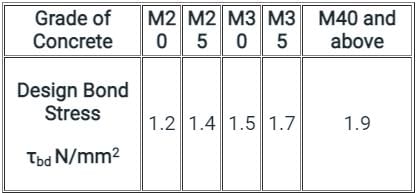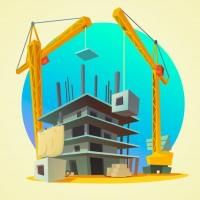Civil Engineering (CE) Exam > Civil Engineering (CE) Questions > Bond strength of concrete can be increased by...
Start Learning for Free
Bond strength of concrete can be increased by:
- a)using lowest grade of concrete
- b)using lowest grade of steel
- c)using plain bars instead of deformed bars
- d)using deformed bars instead of plain bars
Correct answer is option 'D'. Can you explain this answer?
Most Upvoted Answer
Bond strength of concrete can be increased by:a)using lowest grade of ...
Bond strength is the measure of the adhesion or grip between the concrete and reinforcing steel bars in reinforced concrete structures. A higher bond strength is desirable as it ensures the effective transfer of stress between the concrete and steel, thereby enhancing the overall structural integrity. Several factors can influence the bond strength of concrete, including the grade of concrete and steel, as well as the type of reinforcing bars used.
Using Deformed Bars Instead of Plain Bars:
One of the most effective ways to increase bond strength in concrete is by using deformed bars instead of plain bars. Deformed bars are steel bars with deformations or ribs along their length, which provide a larger surface area for the concrete to grip onto. These deformations create interlocking mechanisms between the concrete and steel, improving the bond strength significantly. In contrast, plain bars have a smooth surface, offering less surface area for the concrete to adhere to, resulting in a weaker bond.
The key reasons why using deformed bars instead of plain bars increases bond strength are as follows:
1. Increased Surface Area: The deformations on the surface of deformed bars increase the surface area, allowing for more contact points with the concrete. This increased surface area enhances the bond between the two materials, improving the overall bond strength.
2. Mechanical Interlock: The deformations on the bars create a mechanical interlock with the surrounding concrete, preventing slippage or separation between the steel and concrete. This interlock mechanism transfers the stress between the two materials effectively, leading to higher bond strength.
3. Improved Anchorage: Deformed bars provide better anchorage within the concrete due to the interlocking effect. This anchorage prevents the bars from pulling out or slipping from the concrete, ensuring the load transfer is distributed evenly and enhancing the bond strength.
4. Better Confinement: The deformations on the bars also contribute to better confinement of the concrete around the steel, especially in regions where high shear forces are present. This confinement enhances the overall bond strength and structural performance.
In conclusion, using deformed bars instead of plain bars is the correct option to increase bond strength in concrete. The deformations on the bars provide a larger surface area, mechanical interlock, improved anchorage, and better confinement, all of which contribute to a stronger bond between the concrete and steel.
Using Deformed Bars Instead of Plain Bars:
One of the most effective ways to increase bond strength in concrete is by using deformed bars instead of plain bars. Deformed bars are steel bars with deformations or ribs along their length, which provide a larger surface area for the concrete to grip onto. These deformations create interlocking mechanisms between the concrete and steel, improving the bond strength significantly. In contrast, plain bars have a smooth surface, offering less surface area for the concrete to adhere to, resulting in a weaker bond.
The key reasons why using deformed bars instead of plain bars increases bond strength are as follows:
1. Increased Surface Area: The deformations on the surface of deformed bars increase the surface area, allowing for more contact points with the concrete. This increased surface area enhances the bond between the two materials, improving the overall bond strength.
2. Mechanical Interlock: The deformations on the bars create a mechanical interlock with the surrounding concrete, preventing slippage or separation between the steel and concrete. This interlock mechanism transfers the stress between the two materials effectively, leading to higher bond strength.
3. Improved Anchorage: Deformed bars provide better anchorage within the concrete due to the interlocking effect. This anchorage prevents the bars from pulling out or slipping from the concrete, ensuring the load transfer is distributed evenly and enhancing the bond strength.
4. Better Confinement: The deformations on the bars also contribute to better confinement of the concrete around the steel, especially in regions where high shear forces are present. This confinement enhances the overall bond strength and structural performance.
In conclusion, using deformed bars instead of plain bars is the correct option to increase bond strength in concrete. The deformations on the bars provide a larger surface area, mechanical interlock, improved anchorage, and better confinement, all of which contribute to a stronger bond between the concrete and steel.
Free Test
FREE
| Start Free Test |
Community Answer
Bond strength of concrete can be increased by:a)using lowest grade of ...
Bond stress:
- When the steel bars are embedded in concrete, the concrete after setting adheres to the surface of the bars and thus resist any force that tends to pull or push this rod. The intensity of this adhesive force is called bond stress.
- It is the longitudinal shear stress acting on the surface between the steel and concrete. The term bond is used to describe the means by which slip between the steel and concrete is prevented.
- The bond is provided by anchoring the bars properly and extending the bars beyond the point of maximum shear.
Bond strength is affected by many factors. The following factors attempt to increase the bond strength:
- Using ribbed/deformed bars instead of plain bars.
- Using smaller diameter bars
- use of higher concrete grade
- Increasing the cover around the bar
- Increasing the length of embedment, hooks, bends, etc.
- Using mechanical anchorages
- Proper curing
Additional Information
The permissible bond stress for the different grades of concrete are tabulated below:
As per IS 456: 2000, Clause 26.2.1.1,
In limit state method of design, the design bond strength for plain bars in tension are given below in the table:

Note:
The permissible bond stress for the different grades of concrete are tabulated below:
As per IS 456: 2000, Clause 26.2.1.1,
In limit state method of design, the design bond strength for plain bars in tension are given below in the table:

Note:
- The above value bond stress is for the plain bar in tension.
- The value of bond stress is increased by 60 % when deformed bars are used.
- The value of bond stress is increased by 25 % when the bar is in compression.

|
Explore Courses for Civil Engineering (CE) exam
|

|
Similar Civil Engineering (CE) Doubts
Bond strength of concrete can be increased by:a)using lowest grade of concreteb)using lowest grade of steelc)using plain bars instead of deformed barsd)using deformed bars instead of plain barsCorrect answer is option 'D'. Can you explain this answer?
Question Description
Bond strength of concrete can be increased by:a)using lowest grade of concreteb)using lowest grade of steelc)using plain bars instead of deformed barsd)using deformed bars instead of plain barsCorrect answer is option 'D'. Can you explain this answer? for Civil Engineering (CE) 2025 is part of Civil Engineering (CE) preparation. The Question and answers have been prepared according to the Civil Engineering (CE) exam syllabus. Information about Bond strength of concrete can be increased by:a)using lowest grade of concreteb)using lowest grade of steelc)using plain bars instead of deformed barsd)using deformed bars instead of plain barsCorrect answer is option 'D'. Can you explain this answer? covers all topics & solutions for Civil Engineering (CE) 2025 Exam. Find important definitions, questions, meanings, examples, exercises and tests below for Bond strength of concrete can be increased by:a)using lowest grade of concreteb)using lowest grade of steelc)using plain bars instead of deformed barsd)using deformed bars instead of plain barsCorrect answer is option 'D'. Can you explain this answer?.
Bond strength of concrete can be increased by:a)using lowest grade of concreteb)using lowest grade of steelc)using plain bars instead of deformed barsd)using deformed bars instead of plain barsCorrect answer is option 'D'. Can you explain this answer? for Civil Engineering (CE) 2025 is part of Civil Engineering (CE) preparation. The Question and answers have been prepared according to the Civil Engineering (CE) exam syllabus. Information about Bond strength of concrete can be increased by:a)using lowest grade of concreteb)using lowest grade of steelc)using plain bars instead of deformed barsd)using deformed bars instead of plain barsCorrect answer is option 'D'. Can you explain this answer? covers all topics & solutions for Civil Engineering (CE) 2025 Exam. Find important definitions, questions, meanings, examples, exercises and tests below for Bond strength of concrete can be increased by:a)using lowest grade of concreteb)using lowest grade of steelc)using plain bars instead of deformed barsd)using deformed bars instead of plain barsCorrect answer is option 'D'. Can you explain this answer?.
Solutions for Bond strength of concrete can be increased by:a)using lowest grade of concreteb)using lowest grade of steelc)using plain bars instead of deformed barsd)using deformed bars instead of plain barsCorrect answer is option 'D'. Can you explain this answer? in English & in Hindi are available as part of our courses for Civil Engineering (CE).
Download more important topics, notes, lectures and mock test series for Civil Engineering (CE) Exam by signing up for free.
Here you can find the meaning of Bond strength of concrete can be increased by:a)using lowest grade of concreteb)using lowest grade of steelc)using plain bars instead of deformed barsd)using deformed bars instead of plain barsCorrect answer is option 'D'. Can you explain this answer? defined & explained in the simplest way possible. Besides giving the explanation of
Bond strength of concrete can be increased by:a)using lowest grade of concreteb)using lowest grade of steelc)using plain bars instead of deformed barsd)using deformed bars instead of plain barsCorrect answer is option 'D'. Can you explain this answer?, a detailed solution for Bond strength of concrete can be increased by:a)using lowest grade of concreteb)using lowest grade of steelc)using plain bars instead of deformed barsd)using deformed bars instead of plain barsCorrect answer is option 'D'. Can you explain this answer? has been provided alongside types of Bond strength of concrete can be increased by:a)using lowest grade of concreteb)using lowest grade of steelc)using plain bars instead of deformed barsd)using deformed bars instead of plain barsCorrect answer is option 'D'. Can you explain this answer? theory, EduRev gives you an
ample number of questions to practice Bond strength of concrete can be increased by:a)using lowest grade of concreteb)using lowest grade of steelc)using plain bars instead of deformed barsd)using deformed bars instead of plain barsCorrect answer is option 'D'. Can you explain this answer? tests, examples and also practice Civil Engineering (CE) tests.

|
Explore Courses for Civil Engineering (CE) exam
|

|
Signup to solve all Doubts
Signup to see your scores go up within 7 days! Learn & Practice with 1000+ FREE Notes, Videos & Tests.



























